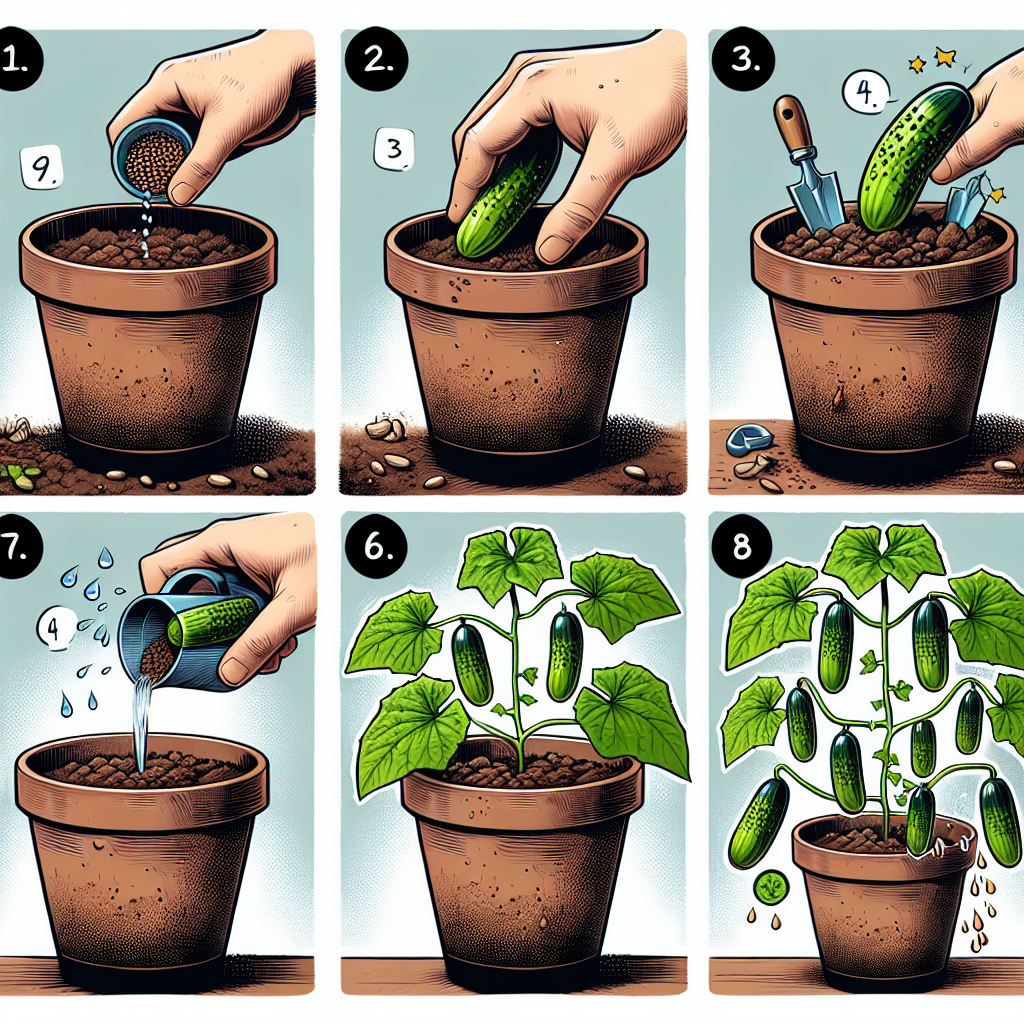
How to grow cucumbers in pots
How to Grow Cucumbers in Pots: A Comprehensive Guide
Cucumbers are a popular garden crop, known for their refreshing taste and versatility in dishes. Growing cucumbers in pots is an excellent option for those with limited gardening space, such as urban dwellers or those with small backyards. In this guide, we’ll explore everything you need to know about successfully cultivating cucumbers in containers, from selecting the right varieties to ensuring they thrive in their pot environment.
Why Grow Cucumbers in Pots?
Growing cucumbers in pots offers numerous advantages:
- Space Efficiency: Pots can be placed on patios, balconies, or anywhere sunlight is available.
- Mobility: You can move pots to take advantage of the best sunlight or shelter from harsh weather.
- Soil Control: Container gardening allows you to control the soil quality, ensuring your plants receive the right nutrients.
- Pest Management: It’s easier to monitor plants in pots, minimizing the risk of pest infestations.
With these benefits in mind, let’s dive into the specifics of how to grow cucumbers in pots.
Choosing the Right Container
When it comes to growing cucumbers in pots, the choice of container is crucial for their support and health. Here are some guidelines to follow:
- Size: A pot should be at least 5 gallons in size to accommodate the roots and allow adequate growth.
- Material: Choose materials such as plastic, ceramic, or wooden pots that can retain moisture while also allowing for drainage.
- Drainage Holes: Ensure the pot has holes at the bottom to prevent waterlogging, which can lead to root rot.
Choosing the Right Cucumber Variety
Not all cucumber varieties are suitable for container gardening. Here are a few types that do particularly well in pots:
- Bush Varieties: These are compact and grow well in containers. Examples include Picklebush or Patio Snacker.
- Vining Varieties: While these require more space and support, they can still be grown in larger pots. Examples include Marketmore and English cucumbers.
Essential Soil and Nutrients
Providing the right soil and nutrients is paramount for healthy cucumber plants. Here’s how to set your potted cucumbers up for success:
- Soil Mix: Use a high-quality potting mix that drains well. You can also add compost for additional nutrients.
- Fertilization: Cucumbers are heavy feeders. Use a balanced fertilizer every few weeks to keep them nourished throughout their growing season.
Planting Your Cucumbers
Once you have your container, variety, and soil ready, it’s time to plant your cucumbers. Follow these steps for optimal results:
- Timing: Wait until the last frost date in your area before planting. Cucumbers thrive in warm weather.
- Seeds or Transplants: You can start cucumbers from seeds or buy young plants from a nursery. If using seeds, plant them 1 inch deep.
- Spacing: If planting multiple seeds, space them at least 18 inches apart to ensure healthy growth.
Watering Your Container Cucumbers
Watering is crucial for the health of your cucumber plants. Here are some tips to ensure they stay hydrated:
- Keep Moist: Cucumbers need consistent moisture. Water them thoroughly at least once a week.
- Check Soil: Before watering, check if the top 1-2 inches of soil are dry; if they are, it’s time to water again.
- Avoid Water Stress: Signup for a watering schedule, as fluctuating moisture levels can cause cucumbers to be bitter and misshapen.
Supporting Your Cucumber Plants
If you choose vining cucumber varieties, they will require support as they grow. Construct supports using:
- Trellises: A vertical support can save space and improve air circulation.
- Fences: You may use garden fences for plants to climb.
- Cages: Tomato cages can also work well for providing stability.
Pest and Disease Management
Like all plants, cucumbers are susceptible to pests and diseases. Here’s how to keep them healthy:
- Common Pests: Watch out for aphids, spider mites, and cucumber beetles. Insecticidal soap can help control these pests.
- Fungal Diseases: Powdery mildew is common in cucumbers. Ensure good airflow and avoid overhead watering to minimize moisture on the leaves.
- Regular Inspection: Regularly check your plants for signs of distress and take action promptly.
Harvesting Your Cucumbers
Knowing when to harvest cucumbers is essential for optimal flavor. Here are some tips:
- Size: Most cucumbers are ready for harvest when they are about 6-8 inches long, depending on the variety.
- Color: Look for bright green, shiny cucumbers without any yellowing.
- Regular Harvesting: Regularly pick cucumbers to encourage the plant to produce more fruit.
Storing Your Harvest
After harvesting, store cucumbers properly to maximize freshness. Here’s how:
- Temperature: Keep cucumbers at cool temperatures, around 50°F (10°C), to extend their shelf life.
- Humidity: Keeping the humidity high, such as placing them in a produce drawer, can also help maintain freshness.
Conclusion: Enjoying Your Homegrown Cucumbers
Growing cucumbers in pots can be a rewarding experience, offering the delight of homegrown produce right at your fingertips. With the right container, soil, variety, and care, you can enjoy fresh cucumbers throughout the season. So gather your supplies, follow this guide, and enjoy the success of your gardening efforts!
"Gardening adds years to your life and life to your years." - Unknown
Remember, patience and care are key. Happy gardening!
By Guest, Published on August 8th, 2024